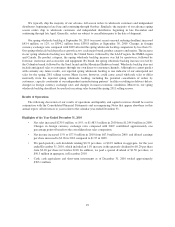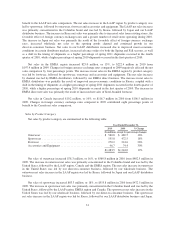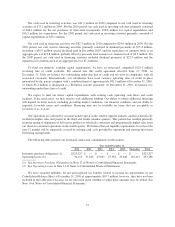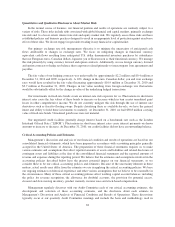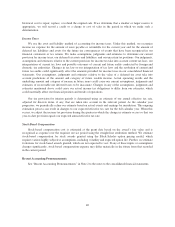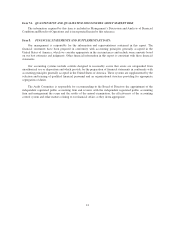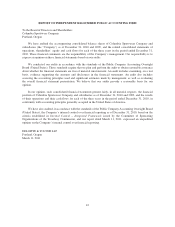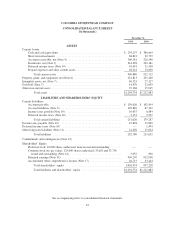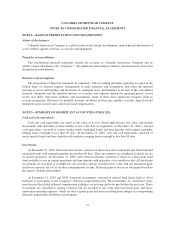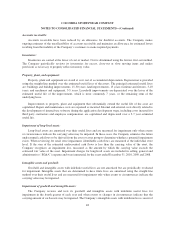Columbia Sportswear 2010 Annual Report Download - page 44
Download and view the complete annual report
Please find page 44 of the 2010 Columbia Sportswear annual report below. You can navigate through the pages in the report by either clicking on the pages listed below, or by using the keyword search tool below to find specific information within the annual report.Quantitative and Qualitative Disclosures About Market Risk
In the normal course of business, our financial position and results of operations are routinely subject to a
variety of risks. These risks include risks associated with global financial and capital markets, primarily exchange
rate risk and, to a lesser extent, interest rate risk and equity market risk. We regularly assess these risks and have
established policies and business practices designed to result in an appropriate level of protection against an adverse
effect of these risks. We do not engage in speculative trading in any financial or capital market.
Our primary exchange rate risk management objective is to mitigate the uncertainty of anticipated cash
flows attributable to changes in exchange rates. We focus on mitigating changes in functional currency
equivalent cash flows resulting from anticipated U.S. dollar denominated inventory purchases by subsidiaries
that use European euros, Canadian dollars, Japanese yen or Korean won as their functional currency. We manage
this risk primarily by using currency forward and option contracts. Additionally, we use foreign currency forward
and option contracts to hedge net balance sheet exposures related primarily to intercompany loan agreements and
payables.
The fair value of our hedging contracts was unfavorable by approximately $2.2 million and $0.4 million at
December 31, 2010 and 2009, respectively. A 10% change in the euro, Canadian dollar, yen and won exchange
rates would have resulted in the fair value fluctuating approximately $10.9 million at December 31, 2010 and
$9.7 million at December 31, 2009. Changes in fair value resulting from foreign exchange rate fluctuations
would be substantially offset by the change in value of the underlying hedged transactions.
Our investments in fixed-rate bonds create an interest-rate risk exposure for us. Fluctuations in short-term
interest rates cause the fair values of these bonds to increase or decrease which in turn creates unrealized gain/
losses in other comprehensive income. We do not currently mitigate this risk through the use of interest rate
derivatives such as fixed-to-floating swaps. Despite classifying these as available-for-sale, we have the general
intent and ability to hold these investments to maturity. At December 31, 2010 we had $58.8 million carrying
value of fixed-rate bonds. Unrealized gain/losses were not material.
Our negotiated credit facilities generally charge interest based on a benchmark rate such as the London
Interbank Offered Rate (“LIBOR”). Fluctuations in short-term interest rates cause interest payments on drawn
amounts to increase or decrease. At December 31, 2010, our credit facilities did not have an outstanding balance.
Critical Accounting Policies and Estimates
Management’s discussion and analysis of our financial condition and results of operations are based on our
consolidated financial statements, which have been prepared in accordance with accounting principles generally
accepted in the United States of America. The preparation of these financial statements requires us to make
various estimates and assumptions that affect reported amounts of assets and liabilities and related disclosure of
contingent assets and liabilities at the date of the consolidated financial statements and the reported amounts of
revenue and expenses during the reporting period. We believe that the estimates and assumptions involved in the
accounting policies described below have the greatest potential impact on our financial statements, so we
consider these to be our critical accounting policies and estimates. Because of the uncertainty inherent in these
matters, actual results may differ from the estimates we use in applying the critical accounting policies. We base
our ongoing estimates on historical experience and other various assumptions that we believe to be reasonable in
the circumstances. Many of these critical accounting policies affect working capital account balances, including
the policy for revenue recognition, the allowance for doubtful accounts, the provision for potential excess,
closeout and slow moving inventory, product warranty, income taxes and stock-based compensation.
Management regularly discusses with our Audit Committee each of our critical accounting estimates, the
development and selection of these accounting estimates, and the disclosure about each estimate in
Management’s Discussion and Analysis of Financial Condition and Results of Operations. These discussions
typically occur at our quarterly Audit Committee meetings and include the basis and methodology used in
38



